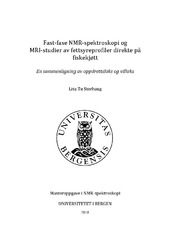| dc.contributor.author | Storhaug, Lisa Tu | |
| dc.date.accessioned | 2018-08-15T15:24:55Z | |
| dc.date.issued | 2018-06-28 | |
| dc.date.submitted | 2018-06-27T22:00:06Z | |
| dc.identifier.uri | https://hdl.handle.net/1956/18110 | |
| dc.description.abstract | The purpose of this project has been to determine the fat content, fat distribution and fatty acid composition in wild and farmed salmon using solid-state Nuclear Magnetic Resonance (NMR) spectroscopy and Magnetic Resonance Imaging (MRI). Rapid growth in the aquaculture industry over the past decades has, due to lack of enough marine resources, resulted in limited access to marine ingredients in the salmon feed. This has led to an increased use of alternative vegetable ingredients causing important long-chain marine ω-3-fatty acids like EPA and DHA to be replaced by shorter acyl chain fatty acids from vegetable oils like ALA. The composition of fatty acids in the salmon diet has shown to be reflected in the fatty acid composition of the filet, as well as affecting the fat profile in other parts of the fish. There is a lot of ongoing research on the use of alternative ingredients in the feed. For this purpose, effective and accurate analytical tools for control of salmon filet quality are required. The development of the feed composition causes a continuous change in quality and fatty acid composition in farmed salmon. Therefore, fast and direct techniques for analyzing salmon is of national and international interest. To quantify the fatty acids in salmon, it is important to have a precise analytical and quantitative method. In this project, solid-state 13^C NMR is used to verify a method that has recently been prepared to quantify the fatty acid composition in salmon. Further, solid-state 31^P NMR, both static and magic angle spinning, is used to investigate the phosphorous compounds in phospholipids in the salmon meat. MRI is used to investigate the fat distribution in the fillet and heart. Results showed that farmed salmon had a total fat content of 10%, twice the amount as in the wild salmon. Furthermore, the content of EPA and DHA is found to be 9.0% and 14.5% in the wild salmon, compared to 3.3% and 4.7% in farmed salmon, respectively. In addition, the farmed salmon contained 9,1% ALA. The phosphorus spectra showed differences in the phosphorous profiles of the salmons. The results from MRI showed differences in fat content and fat distribution in the fillets. In addition, MRI of the hearts of the salmons showed that the farmed salmon stored fat around the heart. The conclusion of this research is that there are significant differences in fat content, fat distribution and fat composition in farmed and wild salmon, and that solid-state NMR spectroscopy and MRI are reliable alternatives to current established methods. | en_US |
| dc.description.abstract | Formålet med dette arbeidet har vært å bestemme fettinnhold, fettfordeling og fettsammensetning i villaks og oppdrettslaks ved hjelp av fast-fase kjernemagnetisk resonans (NMR) spektroskopi og magnetisk resonans avbildning (MRI). Hurtig vekst i oppdrettsnæringen de siste tiårene har resultert i at tilgangen til de marine råvarene i fôret er blitt begrenset på grunn av knapphet av de marine råvarene. Dette har ført til økt bruk av alternative vegetabilske råvarer. Den økende andelen av vegetabilske ingredienser gjør at viktige langkjedete marine ω-3-fettsyrer som EPA og DHA er byttet ut med kortere-kjedede fettsyrer fra vegetabilske planteoljer som alfalinolensyre (ALA). Sammensetningen av fettsyrer i dietten til laksen har vist seg å gjenspeiles i fettsyresammensetningen i fileten, samt påvirke fettprofilen i andre deler av fisken. Det pågår mye forskning på bruk av alternative råvarer i fôret. For dette formålet er det nødvendig med effektive og presise analytiske verktøy for å kontrollere laksekvaliteten. Utviklingen av fôrsammensetningen forårsaker en kontinuerlig endring i kvaliteten og fettsyresammensetningen i oppdrettslaks. Derfor er hurtige og direkte teknikker for analyse av laks av stor nasjonal og internasjonal interesse. For å kvantifisere fettsyrene i laks er det viktig med en presis analytisk metode som er kvantitativ. I dette arbeidet brukes fast-fase 1^H NMR for å bestemme fettinnholdet i laks på en rask måte. Fast-fase 13^C NMR brukes for å verifisere en metode som nylig er utarbeid for å kvantifisere fettsyresammensetningen i laksen. Videre brukes fast-fase 31^P-NMR, både statisk og spinnende for å undersøke fosforforbindelser i fosfolipider i fiskekjøttet. MRI brukes for å undersøke fettfordeling i filet og hjerte. Resultatene viste at oppdrettslaksen hadde et totalt fettinnhold på 10%, noe som var dobbelt så høyt som i villaksen. Videre ble innholdet av EPA og DHA funnet til å være henholdsvis 9,0% og 14,5% i villaksen, sammenlignet med 3,3% og 4,7% i oppdrettslaksen. I tillegg inneholdt sistnevnte 9,1% ALA. Fosforspektrene viste ulikheter i fosforprofilene i laksene. Resultatene fra MRI viste forskjeller i fettinnhold og fordeling av fett i filetene. I tillegg viste MRI av hjertet til laksene at oppdrettslaksen lagret fett rundt hjertet. Konklusjonen i dette arbeidet er at det er forskjeller i fettinnhold, fettfordeling og fettsammensetning i oppdrettslaks og villaks, og at fast-fase NMR-spektroskopi og MRI er pålitelige alternativer til nåværende etablerte metoder. | en_US |
| dc.language.iso | nob | eng |
| dc.publisher | The University of Bergen | en_US |
| dc.title | Fast-fase NMR-spektroskopi og MRI-studier av fettsyreprofiler direkte på fiskekjøtt. En sammenligning av oppdrettslaks og villaks | en_US |
| dc.type | Master thesis | |
| dc.date.updated | 2018-06-27T22:00:06Z | |
| dc.rights.holder | Copyright the Author. All rights reserved | en_US |
| dc.description.degree | Masteroppgave i kjemi | en_US |
| dc.description.localcode | MAMN-KJEM | |
| dc.description.localcode | KJEM399 | |
| dc.subject.nus | 752299 | eng |
| fs.subjectcode | KJEM399 | |
| fs.unitcode | 12-31-0 | |
| dc.date.embargoenddate | 2020-06-01 | |
